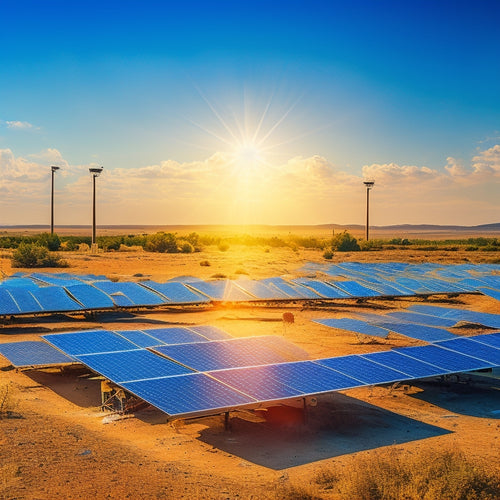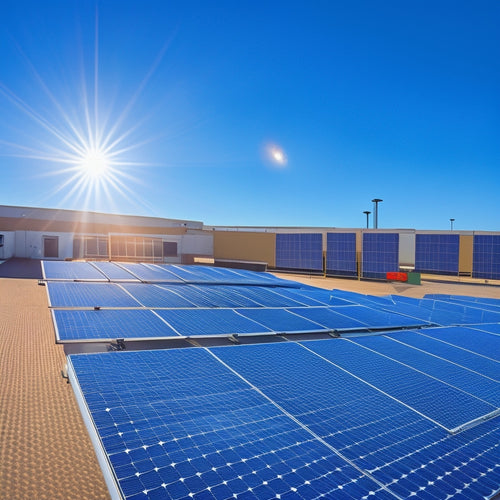
Ideal Location for a Solar Ground Mount
Share
To find the ideal location for a solar ground mount, prioritize areas with maximum sunlight exposure. Choose a site that faces true south in the Northern Hemisphere and consider seasonal adjustments to the panel tilt for peak energy capture. Perform a solar path analysis to minimize shade from trees and buildings, enhancing overall energy efficiency. Additionally, verify the soil is well-drained to support stability and avoid erosion. By implementing these strategies, you'll increase energy production and achieve long-term cost savings. Exploring more aspects of site selection can further enhance your solar investment.
At a Glance
- Choose a location with maximum sun exposure, ideally south-facing in the Northern Hemisphere, to optimize energy generation throughout the day.
- Conduct a thorough site assessment to identify and manage potential shade sources from trees, buildings, and other obstructions.
- Ensure proper soil type and drainage to provide stability and prevent erosion for the solar ground mount installation.
- Utilize adjustable mounts to optimize panel tilt seasonally, capturing more sunlight during winter and summer months.
- Consider financial incentives and long-term savings when evaluating the investment in solar ground mounts for energy independence.
Maximize Sunlight Exposure
To maximize sunlight exposure for your solar ground mount, you'll need to conduct a solar path analysis to understand how sunlight moves across your site throughout the year.
This analysis is essential for ensuring that your solar panels can generate the highest possible output, aligning with your energy generation goals for both partial offset and net-zero energy.
Implementing shade minimization strategies is vital to reducing obstructions that can block sunlight, such as trees and buildings.
By carefully selecting the location and optimizing your setup, you can greatly enhance the efficiency of your solar energy system.
energy efficiency improvements
Solar Path Analysis
A thorough solar path analysis is essential for maximizing sunlight exposure in solar ground mount systems. By understanding solar angles and seasonal variations, you can position your solar panels to capture the most sunlight throughout the year. This analysis involves observing the sun's path in your specific location, helping you determine the ideal tilt and orientation of your panels.
Here's a simplified breakdown of solar path elements:
| Aspect | Details |
|---|---|
| Solar Angles | Varies based on time of day and year |
| Seasonal Variations | Affects sunlight availability |
| Ideal Orientation | Generally south-facing in the Northern Hemisphere |
| Panel Tilt Angle | Adjust according to latitude |
Shade Minimization Strategies
Minimizing shade is essential for maximizing sunlight exposure in solar ground mount installations. To achieve this, you need to conduct a thorough site assessment, identifying potential sources of shade such as nearby trees, buildings, or other structures.
Effective vegetation management is important; trimming or removing overhanging branches can greatly enhance your system's performance. Consider the angle and height of surrounding vegetation to guarantee it won't cast shadows on your solar panels, especially during critical sunlight hours.
Utilizing sunlight reflection techniques can also improve energy capture. You might investigate reflective surfaces nearby that can bounce additional sunlight onto your panels, effectively increasing their light exposure without the need for additional space.
Furthermore, selecting the right location for your solar ground mount is fundamental. Aim for areas with minimal obstructions and maximum sun access throughout the year.
Positioning the panels at an ideal tilt angle can further reduce the impact of any remaining shade, allowing for maximum sunlight absorption. By implementing these shade minimization strategies, you'll tap into the full potential of your solar ground mount system, guaranteeing you enjoy the freedom that clean energy offers.
Increased Energy Efficiency
To achieve increased energy efficiency with your solar ground mount, you'll need to prioritize ideal sun exposure.
Conducting a thorough site assessment is essential to identify potential shading obstacles and evaluate the topography of your land.
Positioning your panels to capture maximum sunlight minimizes energy loss and enhances overall system performance.
Optimal Sun Exposure
Choosing the right location for your solar ground mount can greatly enhance energy efficiency by maximizing sun exposure throughout the day.
To achieve ideal sun exposure, consider the solar panel orientation. Position your panels to face true south in the Northern Hemisphere, or true north in the Southern Hemisphere, as this maximizes direct sunlight capture.
It's essential to account for any potential shading from trees, buildings, or other obstructions that could diminish your solar output.
Additionally, seasonal adjustments can notably impact energy production. As the sun's angle changes throughout the year, consider using adjustable mounts to tilt your panels for peak efficiency during different seasons.
For instance, a steeper tilt in winter can capture more sunlight, while a flatter angle in summer may be more beneficial.
Reduced Energy Loss
Reducing energy loss is vital for maximizing the overall efficiency of your solar ground mount system. When you conduct a thorough site assessment, you can identify and mitigate factors that may compromise system performance. A solid understanding of environmental factors, such as shading from trees or buildings, is essential in this process.
To achieve peak energy efficiency, consider the following aspects:
| Aspect | Impact on Energy Loss | Considerations |
|---|---|---|
| Installation Techniques | High | Proper angles and spacing improve yield |
| Maintenance Considerations | Medium | Regular cleaning and inspections guarantee longevity |
| Geographical Influences | Variable | Local weather patterns affect output |
Unique Design Advantages
When considering solar ground mounts, unique design advantages greatly enhance energy efficiency and optimize sunlight exposure.
By strategically positioning your panels, you can maximize their surface area and minimize shading, leading to better overall performance.
For instance, south-facing panels can capture direct sunlight during peak hours, which is critical for maximizing energy output, especially with energy production efficiency in mind.
Understanding these design elements will help you make informed decisions for your solar setup.
Enhanced Energy Efficiency
Solar ground mounts offer significant design advantages that enhance energy efficiency, maximizing the overall performance of solar installations. By allowing for adjustable angles and ideal positioning, these mounts facilitate higher energy output, directly impacting your energy consumption.
Unlike rooftop systems, ground mounts can be strategically placed in areas with fewer obstructions, ensuring that your solar panels capture maximum sunlight throughout the day.
Incorporating innovative materials and designs, ground mounts can also minimize energy losses associated with shading and reflection. This focus on efficiency aligns with modern sustainability practices, promoting a greener lifestyle without sacrificing energy reliability.
You'll find that these mounts can accommodate larger solar arrays, making them ideal for both residential and commercial applications.
Additionally, the ability to integrate tracking systems with ground mounts further enhances energy generation, allowing you to utilize the sun's energy more effectively.
This combination of features not only reduces your carbon footprint but also contributes to long-term cost savings, reinforcing your commitment to sustainable living.
Ultimately, choosing solar ground mounts enables you to achieve greater energy independence while making a positive impact on the environment.
Optimal Sunlight Exposure
The strategic placement of solar ground mounts greatly improves ideal sunlight exposure, a factor that's essential for maximizing energy production.
To optimize your system, consider the solar panel orientation. Properly orienting your panels toward the sun allows for increased energy capture throughout the day. The angle of inclination can considerably affect performance, especially during peak sunlight hours.
Additionally, making seasonal adjustments is vital. As the sun's position changes throughout the year, adjusting the tilt of your panels can enhance efficiency.
For example, tilting your panels steeper in winter months captures more sunlight when the sun is lower in the sky, while a flatter orientation during summer maximizes exposure when the sun is high.
Selecting Based on Soil Type
When selecting a location for your solar ground mount, it's vital to take into account the soil type, as it directly impacts drainage and stability.
Proper soil assessment is fundamental for optimizing energy needs and guaranteeing your system operates efficiently. Well-drained soil guarantees that water doesn't accumulate around your mounts, reducing the risk of erosion or instability.
Additionally, stable soil provides the necessary support for the structure, assuring long-term performance and reliability of your solar installation.
Soil Drainage Importance
Choosing the right soil type can greatly impact the performance and longevity of a solar ground mount system. Soil drainage plays a vital role in ensuring that your installation remains efficient and secure. Poor drainage can lead to soil compaction, which adversely affects foundation stability.
You'll want to assess your soil for its moisture retention capabilities and implement effective drainage solutions to prevent excess water accumulation. Inadequate drainage can lead to erosion control issues, jeopardizing your solar array's placement and integrity.
It's important to evaluate the vegetation impact on your site; dense roots can disrupt your system and alter groundwater management. By integrating appropriate environmental strategies, you can optimize both soil health and drainage efficiency.
When selecting a location, analyze the existing soil type and its capacity to handle water runoff. This understanding will guide you in selecting the best drainage solutions, ensuring that your solar ground mount remains stable and effective.
Ultimately, prioritizing soil drainage not only enhances your solar investment but also supports sustainable practices in managing your land. Making informed choices about soil drainage can lead to a successful solar installation that stands the test of time.
Stability and Support
Choosing an appropriate soil type is fundamental for providing the necessary stability and support for your solar ground mount system. The foundation depth must be sufficient to accommodate the selected anchor types, ensuring structural integrity under various conditions.
Consider the soil's characteristics—sandy soils allow for better drainage but may require deeper foundations for adequate anchoring, while clay soils can provide better support but may necessitate additional seismic considerations.
Wind resistance is another significant factor. You'll want to analyze the local wind patterns during site preparation, as this impacts the required anchoring methods. Effective leveling techniques are essential to prevent settling over time, ensuring your panels remain ideally positioned.
Additionally, think about maintenance access; a well-planned layout will allow for easy servicing without compromising structural durability.
Installation efficiency is improved when you select a soil type that requires minimal alteration.
Cost-Effective Long-Term Investment
Investing in solar ground mounts can lead to considerable financial savings over time.
By utilizing solar energy, you reduce your reliance on traditional utility sources, which can lower your energy bills considerably.
Additionally, the initial investment in solar infrastructure often pays off through various incentives and reduced operating costs, making it a smart long-term financial decision.
Financial Savings Over Time
One of the most persuasive reasons to contemplate solar ground mounts is their potential for significant financial savings over time. By carefully analyzing installation costs against future energy savings, you can achieve a clear return analysis. The initial investment might seem intimidating, but financing options and tax incentives can ease the burden, allowing you to utilize energy independence sooner than expected.
Location benefits play an essential role in maximizing your system's efficiency and savings. A well-placed ground mount can enhance your property value while minimizing your reliance on grid power, contributing to long-term financial stability.
You'll also need to factor in maintenance considerations; fortunately, solar systems typically require minimal upkeep, translating into lower ongoing costs.
Moreover, considering the environmental impact of your solar investment can provide additional motivation. As you reduce your carbon footprint, you'll likely find community support grows, encouraging a sense of belonging among like-minded individuals.
Ultimately, the combination of financial savings, increased property value, and community backing makes investing in solar ground mounts a wise, cost-effective long-term choice that aligns with your desire for freedom and sustainability.
Frequently Asked Questions
How Do I Determine the Best Angle for My Solar Ground Mount?
To determine the best angle for your solar ground mount, analyze your solar orientation and adjust the panel tilt based on seasonal sun paths, maximizing energy capture throughout the year for peak efficiency.
Can Trees Near the Location Affect Solar Panel Performance?
Imagine sunlight dancing on your solar panels. Trees nearby can cast shadows, creating a shading impact that reduces efficiency. Regular tree trimming guarantees your panels bask in full sun, maximizing energy production and your freedom to utilize it.
What Permits Are Needed for Installing a Solar Ground Mount?
You'll need various permit types, like building and electrical permits, for your solar ground mount installation process. Check local regulations to verify compliance, as requirements can vary considerably based on your location and project scope.
Are There Specific Regulations for Solar Installations in My Area?
Oh sure, regulations are just a charming maze! You'll need to steer through zoning laws and installation guidelines. Check your local government's website; they've got the scoop on what's allowed, ensuring your solar dreams don't hit a snag.
How Much Maintenance Do Solar Ground Mounts Require Over Time?
Solar ground mounts require minimal maintenance, primarily ensuring debris removal and periodic inspections. With proper care, you'll enhance solar panel longevity and ground mount durability, maximizing efficiency and long-term energy freedom for your needs.
Explore More
Choosing the ideal location for your solar ground mount isn't just a smart move; it's like hitting the jackpot in energy savings! By maximizing sunlight exposure and considering soil type, you guarantee your system operates at peak efficiency. With unique design advantages, your investment becomes a cost-effective solution that pays dividends for years to come. So, take the time to select the perfect spot—it's the key to utilizing the sun's power and powering your future sustainably.
Related Posts
-

Building an Emergency Backup Solar Power System in 5 Essential Steps
Building an emergency backup solar power system involves five key steps. First, assess your daily energy needs to ide...
-

What Happens Without a Charge Controller in Solar Panels
Without a charge controller in your solar panel system, you risk overheating batteries due to overcharging, which can...
-

Essential Solar Panel Mounts for Commercial Properties
When it comes to essential solar panel mounts for your commercial property, durability and wind resistance are key fa...


